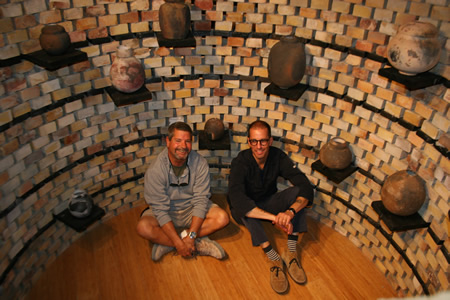
By Robin Pierson, Special to the Independent
In the current “Adam Silverman: Clay and Space” exhibit at Laguna Art Museum, a mason and potter blended their talents to create a sensory installation that wraps viewers in the artistic expressions of both.
To view Silverman’s textured and organic pottery fired in the pits at Aliso Beach, viewers enter into rounded brick, enclosures. Envisioning a burial chamber, a chapel or the cycle of life, Silverman wanted his pots to have “their own room” made of a similar material that had seen “a lot of fire and looked like family.” Choosing bricks previously employed in a commercial kiln used to make clay sewer pipes, Silverman, of Los Angeles, needed a mason to manifest his idea. After speaking with four prospects, Silverman felt a connection with longtime mason and Dana Point resident, Mike Hilburn, online.
For Hilburn, who says he’s gotten more than one job based on the “vibe,” building the structure was an exercise in adhering to the precision of his craft, then letting it go.
A mason for three decades, Hilburn said, “My brain is programmed to be a perfectionist with leveling,” but given the variety in the visibly distressed bricks, perfection was impossible. “Building a radius that’s to be plumb using irregular bricks, some with debris on them, perfection was impossible, so I just tried to keep the radius from deviating too much from perfect.”
Each of the two structures contains 1,100 bricks, a total of six pallets, interspersed with lengths of charred wood. Working within a limited time frame between exhibitions, Hilburn had 10 days to complete the 6’ tall, 9’6’’ diameter structures. “It was brutal,” Hilburn said. A year before, he had undergone extensive back surgery to repair his spine after years of working with rock and stone.
Working 10-hour days, each brick had to be cleaned and hauled from one room into another. “They were extremely dusty, covered with city grime,” Hilburn said. When he was off work, Hilburn’s son, Max, helped. “He’s a very hard worker, just like the old man.”
Beside the variable nature of the materials, Hilburn faced a design challenge. Silverman envisioned the units as permeable.
“The finished product was not to have any mortar between the brick so you could see through structure, but I had to lock in the brick,” Hilburn said. “So it wasn’t like regular brick laying where you butter each side.” Using as little mortar as possible, mixing it in buckets in small batches on the museum floor, Hilburn delicately frosted the bricks, cleaning off the excess with a quarter inch trowel and a tiny paintbrush.
Layered in between the rows of brick are lengths of wood intentionally burnt with a flame-thrower before being handed over to Hilburn to incorporate into the structure as shelves. Both the pots and the wood retain a scorched smell, a sense rarely engaged by an art exhibit.
Silverman fired many of the pots on display in local fire pits using woodchips from the grounds of the Sawdust Festival, driftwood and seaweed from the beach as fuel and seasoning the flames with salt he dehydrated from local waters.
While demanding, Hilburn said building the installation “was a lot more interesting than lying brick in a straight line.” His company, I-tal Masonry, more typically builds foundations, custom fireplaces and sets marble, slate and tile. The museum installation, “opened another venue for me. I’d like to do more in the art world. It was very challenging but one of the most fun things I’ve done in 30 years.”
The exhibit will be on display at the museum until Jan. 19.
Hilburn can be reached at [email protected].




